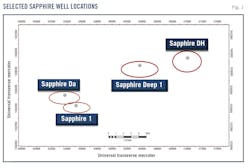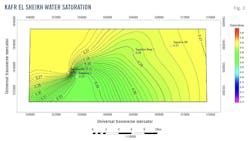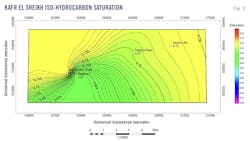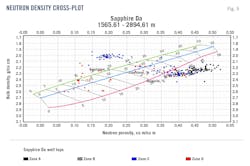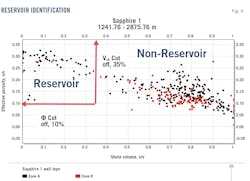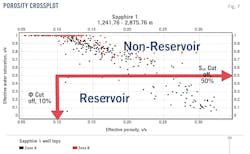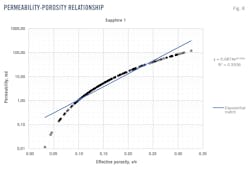Sapphire field petrophysical evaluation reveals reserve trends
Naiem Souilam Sobih
Ahmed Ahmed El Nagar
Ali Elsayed Abbas
Suez University
Egypt
Samir Shehab
Rashid Petroleum Co.
Al Azhar, Egypt
Sapphire field’s Kafr El Sheikh formation in the Nile Delta represents a promising reservoir rock characterized by a diverse range of petrophysical parameters. The relationship between porosity and permeability is fundamental to understanding the reservoir’s characteristics and to guide exploration and production in the delta. Newly developed reservoir-contour maps provide comprehensive static and dynamic models of the field, guiding well-planning initiatives.
The current work used lithological identification techniques to confirm a mixed composition of sandstone and shale within the formation. Development should concentrate in the central and northwest-southeast regions where field maps show increases in effective porosity and hydrocarbon saturation, respectively.
Sapphire field
Sapphire field, about 90 km offshore Alexandria within the Northwest Delta Deep Marine (WDDM) concession in the Nile Delta, extends beyond the boundary between Rosetta and WDDM concessions. Pliocene sandstones, spanning about 90 sq km, contain gas reserves. The reservoir consists of sandstones, mudstones, and siltstones arranged vertically with an overall upward trend.
The sedimentary succession in the Nile Delta spans from the Lower Miocene to the Recent period, with observed variations in thickness and facies. Sediments range from sandstones with gravel lenses in the south to sandstones interlayered with clays in the north, suggesting detrital sediments from the Eastern Desert and Red Sea Hills as sources.
Offshore Nile Delta stratigraphy is classified into three main units: the Plio-Pleistocene unit characterized by shale, the Miocene unit comprising two sand packages separated by the Rosetta Anhydrite formation, and the Middle-Lower Miocene unit primarily composed of shales with sand stringers. Petrophysical analysis of the Kafr El Sheikh formation and reservoir quality assessment in Sapphire field will provide vital insights into the geological processes and hydrocarbon potential in the Nile Delta region.
Kafr El Sheikh petrophysical analysis
Assessment of the petroleum potential within the clastic reservoir rock of the Early to Middle Pliocene Kafr El Sheikh formation derived from data obtained from four wells: Sapphire 1, Sapphire Da, Sapphire Dh, and Sapphire Deep-1 (Fig. 1). This evaluation involved petrophysical analyses of specific intervals within each well.
The calculation of shale volume (Vsh), determined using Equation 1, distinguishes between reservoir and non-reservoir rocks. Net pay thickness is calculated by averaging the pay net flag values from the well logs. Porosity (Φ) and effective shale-corrected porosity (Φeff), calculated using Equations 2 and 3, combine neutron, density, and sonic logs from well logging to obtain reservoir fluid storage capacity.
Fluid saturation analysis identifies water versus hydrocarbons. Hydrocarbons are further categorized into mobile and residual types. Archie's Indonesian equation (Equation 4) provides the most common estimate of water saturation (Sw). Permeability (k) and gas saturation (Sg) require both Sw and irreducible water saturation (Swirr) estimates and are calculated using Equation 5 (Coates' equation) and Equation 6, respectively.
Kafr El Sheikh potential
Effective porosity obtained from the neutron log for each well is shown in Tables 1 and 2. The interpretation of neutron-density logs led to the creation of an effective porosity map for the Kafr El Sheikh formation. The results suggest 14% minimum effective porosity near the Sapphire Da well, with 34% maximum porosity within the vicinity of the same well. The northwest and southeast regions of the study area exhibit promising potential for effective porosity and reservoir storage capacity within the Kafr El Sheikh formation. These areas represent new development trends for the formation, highlighting opportunities for reservoir exploration and production strategies.
To generate a shale volume (Vsh) map, gamma-ray and neutron density methods were combined to calculate shale content. Kafr El Sheikh formation data show 4-34% Vsh. The Vsh trend decreases towards the northwest, suggesting that the northwest areas have potentially favorable reservoir characteristics.
For water saturation, Archie and Indonesia methods calculated water saturation across different wells. Sapphire well logs include water saturation interpretations using both methods. The Indonesia equation generated an iso-effective water saturation map for the Kafr El Sheikh formation, showing 26-35% water saturation distribution across the formation (Fig. 2). Water saturation decreases southeast to northwest.
Table 1 also shows effective water saturation and gas saturation for the formation, and an iso-hydrocarbon saturation map illustrates 67-75% gas saturation in the formation (Fig. 3). Gas saturation decreases northwest to southwest.
A permeability map, derived from effective porosity logs, shows 5-430 md permeability across the field (Fig. 4). Permeability in the formation orientates towards the northwest and southeast areas, suggesting a high likelihood of effective porosity and storage capacity for the reservoir in these regions.
Data from wells in Table 1 calculate net pay thickness for each zone in the formation. These results generated a map showing 0.46-24 m net pay thickness. The trend is oriented northwest to southwest (not shown), where zones exhibit high reservoir potential based on net-pay thickness assessments.
Kafr El Sheikh lithology identification came from a neutron-density cross-plot using established methods. A gamma-ray log-based visual aid showed that the lithology comprises a mix of shale and sandstone, with the Sapphire Da well showing a mix of shale and sandstone containing 14-34% porosity (Fig. 5). These results highlight the complex lithology in this reservoir and the need for precise identification to understand the reservoir's petrophysical characteristics.
The cutoff value for shale (reservoir vs. non-reservoir) uses the relationship between shale content and effective porosity across multiple wells, derived from gamma ray logs. Fig. 6 illustrates a cross-plot of gamma ray against shale content and porosity. The determined cutoff value is 0.35, indicating that rocks with a shale content of 35% or less are classified as reservoir rocks, while those exceeding 35% shale content are classified as non-reservoir rocks.
To drill down further on the commercial potential of the reservoirs, the water saturation-effective porosity cross-plot, combined with gamma-ray logs, differentiates between productive (pay) and non-productive (non-pay) intervals (Fig. 7). A water saturation value below 50% identifies pay zones, while values above 50% indicate non-productive intervals. This cutoff assumes that high water-saturation reduces the likelihood of oil or gas being present, though the cutoff’s accuracy may vary with geological conditions.
The porosity cutoff of the gross sand interval distinguishes between different types of sand intervals. Porosity of 10% or higher indicated sufficient permeability for flow (Fig. 8). This component of the petrophysical analysis also helps differentiate between reservoirs and non-reservoirs.
For example, Sapphire-1 permeability varies by 0.01-117.78 md with a 15.09-md average, and effective porosity varies by 0.03-0.33 md, with a 0.18-md average (Table 2). These parameters are critical for assessing reservoir quality, fluid transmissibility, and hydrocarbon storage capacity. The variability in permeability indicates reservoir heterogeneity, which affects fluid flow efficiency. Understanding these variations is essential for accurate reservoir characterization and effective management strategies in Sapphire field.
Bibliography
- Abdel Aal, A., El Barkooky, A., Gerrits, M., Meyer, H., Schwander, M., and Zaki, H., “Tectonic evolution of the Eastern Mediterranean basin and its significance for hydrocarbon prospectivity in the ultradeepwater of the Nile Delta,” The Leading Edge, Vol. 19, No. 10, October 2000, pp. 1086–1102.
- Alami, R., “Egypt’s domestic natural gas industry,” Oxford Institute for Energy Studies, NG 12, April 2006.
- Cross, N.E., Cunningham A., Cook R.J., Taha A., Esmaie E., and El-Swidan N., “Three-dimensional seismic geomorphology of a deep-water slope-channel system: the Sequoia field, offshore west Nile Delta, Egypt,” AAPG Bulletin, Vol. 93, No. 8, Aug. 1, 2009, pp. 1063–1086.
- Doherty, M., Jamieson, T., Kileni, T., and Trayner, P., “The geology and seismic stratigraphy of the offshore Nile Delta,” Ninth petroleum exploration and production conference, the Egyptian general petroleum corporation. Vol. 2. 1988, pp. 408–426.
- El-Khadragy, A.A., Shazly, T.F., Ramadan, M., El-Sawy, M.Z., “Petrophysical investigations to both Rudeis and Kareem formations, Ras Ghara oil field, Gulf of Suez, Egypt,” Egyptian Journal of Petroleum, Vol. 26, No. 2., 2017, pp. 269–277.
- Harms, J.C. and Wray, J.L., “Nile Delta,” The Geology of Egypt, 1st ed., Routledge, 1990, pp. 329–343.
- Mayall, M., Jones, E., and Casey, M. “Turbidite channel reservoirs key elements in facies prediction and effective development,” Marine and Petroleum Geology, Vol. 23, No. 8, September 2006, pp. 821–841.
- Mayall, M. and Stewart I., “The architecture of turbidite slope channels,” Deep-water reservoirs of the world, SEPM Society for Sedimentary Geology, Vol. 20, Dec. 1, 2000.
- Mohamed, I.A., El-Mowafy, H.Z., and Fathy, M., “Prediction of elastic properties using seismic prestack inversion and neural network analysis,” Interpretation, Vol. 3, No. 2, May 1, 2015, pp. 57–68.
- Samuel, A., Kneller, B., Raslan, S., Sharp, A., and Parsons, C., “Prolific deep-marine slope channels of the Nile Delta, Egypt,” AAPG Bull., Vol. 87, No. 4, Apr. 1, 2003, pp. 541–560.
- Schlumberger, “Geology of Egypt,” Well Evaluation Conference Egypt, Schlumberger Middle East, Cairo, 1984.
- Vandré, C., Cramer, B., Gerling, P., and Winsemann, J., “Natural gas formation in the western Nile delta (Eastern Mediterranean): thermogenic versus microbial,” Organic Geochemistry, Vol. 38, No. 4, April 2007, pp. 523–539.
- Younes, M. “Reservoir characterization and hydrocarbon potential habitat in the Abu Qir gas field, offshore Nile Delta, Egypt,” Proceedings of 5th Conference on Geochemistry, Alexandria University, Alexandria, Egypt, Vol. 2, 2001, pp. 303–324.
